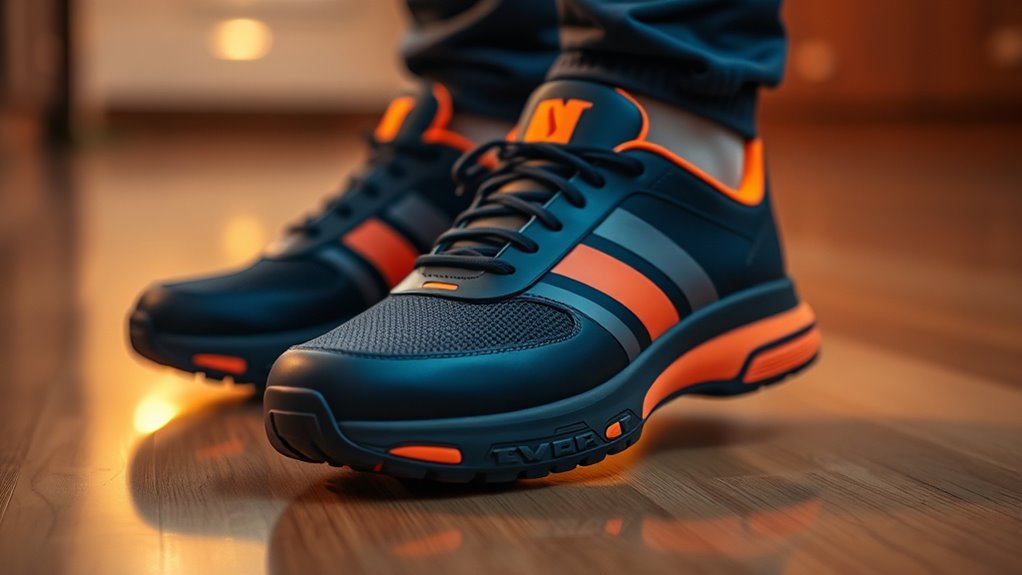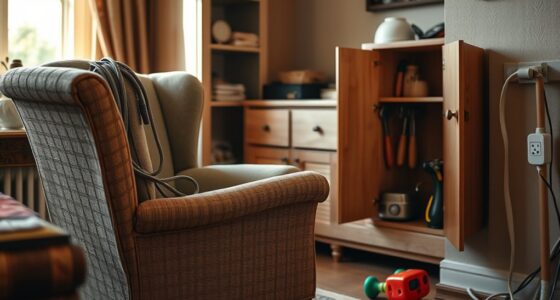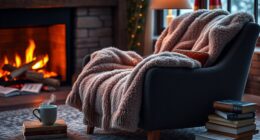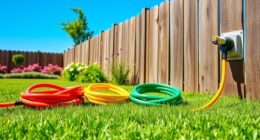Upgrading your indoor footwear with slip-resistant soles and proper support can markedly lower your fall risk. Look for shoes with textured, rubber outsoles that provide good grip, and ensure they fit well to keep you stable. Supportive features like arch support and sturdy heels improve balance, while comfort helps you stay confident on your feet. Choosing the right shoes and maintaining them properly can make a big difference—discover how to make the safest choices for your home.
Key Takeaways
- Switch to shoes with non-slip, textured soles to improve grip on indoor surfaces.
- Choose well-fitting footwear that provides ankle support and stability during indoor movements.
- Regularly inspect and replace shoes showing signs of wear, such as worn soles or reduced traction.
- Opt for lightweight, cushioned shoes with good arch support to enhance comfort and reduce fatigue.
- Store footwear properly in dry, organized spaces to maintain shape and prevent damage that can compromise safety.
Why Footwear Matters for Indoor Safety

Wearing the right footwear is vital for preventing slips and falls indoors. Your indoor shoe aesthetics matter because comfortable, well-fitting shoes help maintain stability and confidence on smooth or slippery surfaces. Choosing seasonal footwear choices ensures you’re prepared for temperature changes and varying floor conditions, reducing the risk of accidents. For instance, lightweight shoes with good grip are ideal in summer, while insulated options with slip-resistant soles work better in colder months. Proper indoor footwear supports your posture and reduces fatigue, which can otherwise lead to missteps. Proper footwear selection based on the environment and your needs can significantly lower fall risk. By paying attention to both style and function, you create a safer environment for yourself and others. The right shoes aren’t just about looks—they’re an indispensable part of fall prevention indoors.
Features to Look for in Fall-Prevention Shoes

When choosing fall-prevention shoes, focus on their traction and grip to prevent slips. Make sure the soles are stable and non-slip to keep your footing secure. Additionally, select shoes that fit well and provide proper support to keep your feet comfortable and stable throughout the day. Good footwear can also boost conflict resolution skills by reducing discomfort and promoting confidence in movement.
Secure Traction and Grip
To prevent slips and falls, choosing shoes with secure traction and grip is essential. Good traction reduces slip hazards, especially on smooth indoor surfaces. Look for footwear with rubber soles designed for grip, as they provide better adherence to floors. Avoid shoes with worn-out treads or smooth soles that increase fall risk. Here’s a quick comparison:
| Shoe Type | Traction Features | Ideal Use |
|---|---|---|
| Rubber-soled shoes | Deep treads, textured surface | Indoor footwear for safety |
| Leather soles | Smooth, polished finish | Less grip, more slip hazards |
| Athletic shoes | Multi-directional grip | Active indoor use |
| Slip-resistant shoes | Specialized slip-proof tread | Elderly or high fall risk |
Choosing the right shoes boosts confidence and safety, reducing fall risks indoors. Proper tuning of your footwear can also enhance grip performance, especially for those who spend extended periods on their feet.
Stable, Non-Slip Soles
Choosing shoes with stable, non-slip soles greatly enhances fall prevention, especially for those at higher risk. Look for footwear with advanced slip resistant technology, which provides better grip on indoor surfaces like tiles or hardwood. A well-designed sole offers consistent traction, reducing the chances of slips caused by slick floors. Additionally, sole durability ensures that the outsole maintains its grip over time, preventing wear that can compromise safety. Durable soles withstand regular use without becoming smooth or slick, maintaining their anti-slip properties. Prioritize shoes with sturdy, textured outsoles that stay effective even after months of wear. Regularly inspecting the soles for signs of wear and sole integrity can help maintain their slip-resistant qualities. By selecting footwear with these features, you markedly lower your risk of falling indoors, giving you greater confidence and stability in daily activities.
Proper Fit and Support
Ensuring your shoes fit properly and provide adequate support is essential for fall prevention. A well-fitting shoe supports your foot arch and helps maintain stability. Look for shoes with: 1. A snug fit around the heel to prevent slipping, complemented by effective heel cushioning for shock absorption. 2. Adequate room in the toe box to avoid squeezing, which can affect balance. 3. Arch support that aligns with your foot’s natural shape, reducing fatigue and improving posture. Proper fit minimizes blisters and discomfort, while support features keep your foot steady during movement. Pay close attention to the heel area and foot arch, as these are critical for stability. Incorporating natural materials like leather or linen can also enhance comfort and breathability. Choosing shoes with these features helps you stay balanced and reduces the risk of falls indoors.
The Importance of Non-Slip Soles

Non-slip soles are essential when it comes to preventing falls, especially on wet or uneven surfaces. They provide the slip resistance needed to keep you steady and reduce the risk of slips. A good non-slip sole is designed with textured or rubberized material that grips various surfaces effectively. Additionally, sole durability matters because your shoes need to withstand daily wear without losing their grip. Investing in footwear with high-quality, slip-resistant soles ensures you maintain traction over time, even in challenging conditions. Remember, the best slip resistance won’t help if the sole quickly wears out. Prioritizing both slip resistance and durability in your footwear can notably lower your fall risk indoors, giving you confidence and stability throughout your day.
Supportive Shoes for Better Balance

A sturdy, supportive shoe goes a long way in maintaining better balance and stability during everyday activities. Look for footwear that offers:
- Enhanced ankle support to prevent wobbling or twisting on uneven surfaces.
- Arch stability to keep your feet properly aligned, reducing fatigue and discomfort.
- A firm, non-slip sole that grips the floor and prevents slips.
- Incorporating Pimple Patch technology into footwear, such as gel inserts or pads, can help cushion your feet and provide extra stability during movement.
These features work together to keep you steady, especially during quick movements or progressions. Supportive shoes help distribute your weight evenly, reducing strain on your ankles and arches. By choosing footwear that prioritizes ankle support and arch stability, you lower your fall risk indoors. Remember, proper support boosts confidence and encourages safer, more secure steps every day.
Choosing the Right Fit and Comfort Level

Finding footwear that fits well and feels comfortable is essential for reducing fall risk. Start with accurate shoe sizing; shoes that are too tight or too loose can cause instability. When trying on shoes, do a comfort assessment by walking around and paying attention to how they feel. Confirm there’s enough room in the toe box to wiggle your toes without slipping forward. Check for a snug fit around the heel to prevent slipping, but avoid tightness that causes discomfort. Remember, comfort isn’t just about softness—firm support and proper fit matter too. If shoes cause pinching or blisters, they’re not the right fit. Prioritize your comfort and get shoes that support your feet well, helping you stay steady and safe indoors. Ensuring your footwear has a secure fit can also reduce the risk of cybersecurity vulnerabilities, which can compromise safety in various settings.
Top Shoe Styles for Indoor Use

When selecting shoes for indoor use, comfort and stability should be your top priorities. The latest indoor footwear trends focus on stylish indoor shoes that support safety without sacrificing looks. Imagine slipping into:
- Cushioned slippers with non-slip soles, perfect for cozy nights and quick errands.
- Low-profile sneakers with arch support, offering stability on smooth floors.
- Slip-on loafers with textured soles, combining elegance with grip for easy wear.
These styles help prevent slips while keeping your look polished. Stylish indoor shoes now blend function and fashion effortlessly, making it easier to stay safe at home. Choosing the right pair means you’ll feel confident moving around, reducing fall risks while enjoying indoor comfort.
Tips for Transitioning to Safer Indoor Footwear

Switching to safer indoor footwear requires mindful choices and gradual adjustments. Begin by selecting shoes that complement your home decor and provide good grip during indoor activities. Shift slowly by wearing your new shoes for short periods, gradually increasing as you feel comfortable. Keep a dedicated space near your entryway for easy access and make it a habit to change shoes when entering. To help you decide, consider this table:
| Tip | Benefit |
|---|---|
| Choose non-slip soles | Reduces fall risk on smooth floors |
| Match shoes to home decor | Encourages consistent use |
| Wear during indoor activities | Builds confidence and comfort |
Additionally, understanding local safety tips can further help prevent falls and create a secure indoor environment.
Maintaining and Replacing Your Indoor Shoes

To keep your indoor shoes safe and supportive, you should regularly check for signs of wear and tear. Store them properly to prevent damage and maintain their shape. Paying attention to these details guarantees your shoes stay comfortable and effective in reducing fall risk. Incorporating regular maintenance of your footwear can further extend their lifespan and safety features.
Regular Wear Checks
Regularly inspecting your indoor shoes is essential to prevent falls and maintain proper support. Over time, wear and tear can compromise their grip and stability. To stay ahead, check your shoes often for signs like:
- Worn-out soles that are smooth or uneven
- Frayed or damaged uppers affecting fit and support
- Persistent odors or stains indicating they’re overdue for replacement
- Proper maintenance techniques can extend the lifespan of your footwear and ensure ongoing safety.
Maintaining good shoe shelf organization helps you spot worn shoes quickly, encouraging better indoor shoe habits. Replace shoes that no longer provide adequate traction or comfort. Regular wear checks ensure your footwear remains reliable, reducing indoor fall risks. Keep an eye on these details, and your indoor shoes will serve you well, keeping you steady and safe every day.
Proper Shoe Storage
Proper shoe storage plays a crucial role in maintaining the condition of your indoor shoes and guaranteeing they’re ready when you need them most. To support shoe care and keep footwear hygienic, store your shoes in a cool, dry place away from direct sunlight. Use individual boxes or breathable bags to prevent dust and dirt buildup. Avoid stacking shoes haphazardly, which can cause deformation or damage. Regularly airing out your shoes helps prevent odors and bacteria growth, promoting footwear hygiene. When shoes show signs of significant wear or damage, replace them promptly to reduce fall risk indoors. Proper storage not only extends the lifespan of your shoes but also ensures they’re clean, supportive, and safe to wear, contributing to a safer, fall-free environment.
Recognizing Wear and Tear
Keeping your indoor shoes in good condition requires more than just proper storage; it also means staying alert to signs of wear and tear. Over time, your shoe material can show cracks, fraying, or thinning, indicating it’s time for replacement. Pay attention to the heel height: if the heel is wobbling, uneven, or worn down, it compromises stability. Additionally, check the sole for smooth spots or thinning tread, which reduces traction. Specifically, look for these signs:
- Cracks or holes in the shoe material, especially around the toe and sides.
- Worn-down heels that no longer provide proper support.
- Smoother soles with less grip, increasing the risk of slips.
- Proper footwear maintenance can extend the lifespan of your indoor shoes and ensure safety. Recognizing these signs early helps ensure your indoor footwear remains safe and supportive.
Frequently Asked Questions
Can Specific Shoe Brands Better Prevent Falls Indoors?
Yes, some shoe brands with strong reputations for safety and quality can better prevent falls indoors. Look for brands known for slip-resistant soles and good grip, like New Balance or Skechers. While aesthetic appeal matters, prioritizing shoes with sturdy construction and reliable traction helps reduce fall risk. You’ll feel more confident on your feet, and the right brand can seamlessly combine safety with style to keep you steady indoors.
How Often Should Indoor Shoes Be Replaced for Safety?
You should replace your indoor shoes every 6 to 12 months to maintain safety. Regularly clean your shoes to remove dirt and debris, which helps preserve sole durability. Check the soles frequently for wear and tear, as worn-out soles can increase fall risk. If you notice significant thinning or damage, it’s time for a new pair. Keeping shoes clean and replacing them when necessary guarantees better grip and reduces your fall risk indoors.
Are There Any Risks Associated With Wearing Indoor Slippers?
Wearing indoor slippers might seem harmless, but slipper safety is a real concern—you could slip, trip, or even face a fall from a tiny misstep! Poor grip or worn-out soles turn your cozy slippers into sneaky hazards. Always choose sturdy indoor footwear with good traction to prevent accidents. Don’t let your comfort compromise your safety; invest in reliable slippers to stay safe and stylish indoors!
Do Certain Materials Improve Indoor Shoe Grip?
Yes, certain materials improve indoor shoe grip. You should look for slip-resistant soles made from rubber or rubber-like compounds, as they provide better traction. A textured sole with a pattern or tread enhances slip resistance by increasing friction with smooth surfaces. When shopping for indoor footwear, prioritize these materials and sole textures to reduce your fall risk and guarantee safer footing around your home.
Can Custom Orthotics Enhance Indoor Fall Prevention?
Sure, custom orthotics can boost your indoor safety, but only if you’re willing to embrace the superhero cape of ankle stability and arch support. They help align your feet, reduce slips, and prevent pesky falls. So, slip into orthotics and give your feet the support they crave—because falling isn’t part of your daily plan, and your ankles deserve the best defense against gravity’s pranks.
Conclusion
Choosing the right indoor shoes isn’t just about style—it’s about safeguarding your steps. Like a steady anchor in a storm, the right footwear keeps you balanced and confident, reducing fall risks. So, invest in supportive, non-slip shoes that fit well and feel comfortable. Remember, your safety depends on the choices you make today. Step into a safer tomorrow—because every confident step counts in protecting your independence and well-being.









